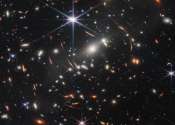Diagnosis murder: Study shows supermassive black holes may strip galaxies of life
(PhysOrg.com) -- Black holes have long been beloved of science fiction writers for their destructive capabilities and peculiar ability to warp space time. Now a study led by researchers from The University of Nottingham reveals ...









